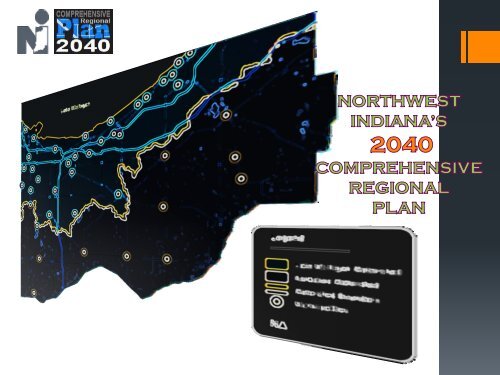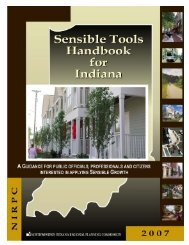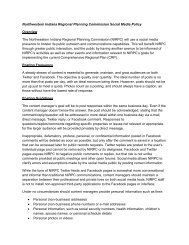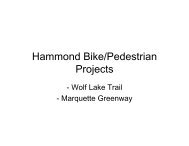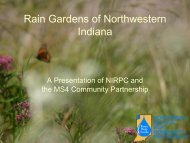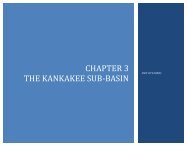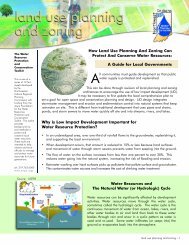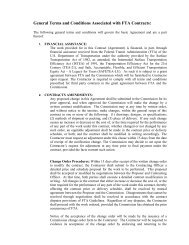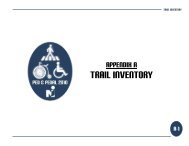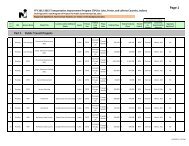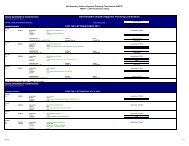Download PDF - Northwestern Indiana Regional Planning ...
Download PDF - Northwestern Indiana Regional Planning ...
Download PDF - Northwestern Indiana Regional Planning ...
You also want an ePaper? Increase the reach of your titles
YUMPU automatically turns print PDFs into web optimized ePapers that Google loves.
Plan OverviewThe CRP represents the first broad planninginitiative covering Lake, Porter and LaPortecounties. Unlike previous plans released byNIRPC, which focused primarily ontransportation, the CRP marries into the mixland use, human and economic resources,and environmental policy objectives.
NIRPC 2040 Comprehensive<strong>Regional</strong> PlanThe CRP stresses a number offactors that point to both ourchanging demographics and ourfuture opportunities withrecommendations for:• Growth & Conservation• Transportation• Environment & Green Infrastructure• Human & Economic Resources• Stewardship & Governance
A Vision forNorthwest <strong>Indiana</strong>• The 2040 Plan is built on a “communitybasedregional consensus” - the outcomeof numerous public involvement meetingswith residents and decision makers.• An overall direction, conceived at theForum on the Future of Northwest <strong>Indiana</strong>,a 500-person visioning event held inDecember 2008, is summarized in thevision statement.
The Northwest <strong>Indiana</strong>Region• 3 counties: Lake,Porter, and LaPorte• 41 cities and towns• 2010 population:771,815• 1,520 square miles ofland• 21 miles of LakeMichigan shoreline• 4 Interstates• 1 commuter rail line• Part of the 16 countyChicago combinedstatistical area
An Evolving Region• The fact remains today that our core urbancommunities, such as Gary, Hammond, East Chicagoand Michigan City, continue to lose population and jobs.• A historical trend of high vacancy rates in our coredowntown districts continues to hinder revitalization.• Getting older• Historical growth patterns indicate that, without action,the unincorporated areas of the region will continue tolose their rural character and further the spread ofunsustainable sprawl.• More than 20% of the region’s population resides inunincorporated areas. In Porter and La Porte counties,approximately 40% of the population resides inunincorporated areas. Between 1992 and 2006, totalland developed in the unincorporated areas of theregion grew by 125%.• Between 1992-2006 urban use coverage increased by42% but population increased only by 4.3%.
An Evolving Region• Present trends forecast that job centerswill remain in the urbanized areas of theregion. Unless we are able to keepdevelopment close to our existing centersto save consumption of valuable land.• Many portions of Northwest <strong>Indiana</strong> areunderserved and lack connectivitybetween modes, such as train and bus.• Transportation is inadequately funded andmajor infrastructure improvements areneeded to attract jobs and rebuild our corecities.• The system has no dedicated local fundingsource despite the need of many who are“transit dependent” because of householdincome, age or disability.100%98%96%94%92%90%88%86%84%82%% of VacantUnitsVacant housingunitsTotal HousingUnits9.9% 6.3% 12.3%20,593208,7504,18166,1795,97348,448Lake Porter LaPorte9.9% 6.3% 12.3%20,593 4,181 5,973% of Vacant Units208,750 66,179 48,448
• Unconstrained growth will continue toadversely impact the quality of waterresources we are dependent on in dailylife.• Unchecked growth also threatens our airquality by spreading out more vehiclecongestion.• Brownfields: When industries departfrom a location, they leave behind apotentially contaminated footprint andthus create a “brownfield.”• As our economy continues to move awayfrom a manufacturing and goodseconomy to a services and professionaleconomy, Northwest <strong>Indiana</strong> must adaptto these changing factors and positionourselves successfully to compete in anincreasingly global marketplace.An Evolving Region• Governments in Northwest <strong>Indiana</strong>largely have remained fractured withmultiple units providing services.More cooperation is needed betweenmunicipal units of government to helpachieve cost savings, improved socialjustice and effective landmanagement.
Environmental JusticeAn Evolving RegionNIRPC developed theEnvironmental JusticeBase Map to identifythe areas in Northwest<strong>Indiana</strong> with higherthan averageconcentrations ofminority and lowincomepopulationsand to analyze theimpacts of the 2040CRP.
Northwest <strong>Indiana</strong> Population1970-2010, with 2040 Projection1,000,000950,000940,000900,000870,000850,000800,000771,815810,000750,000700,000738,709751,413711,592741,468650,0001970 1980 1990 2000 20102020 20302040Source: Census Bureau <strong>Indiana</strong> Business Research Center
INVision Northwest <strong>Indiana</strong> - Stretching from the treasured shoresof Lake Michigan to the historic banks of the Kankakee River andcommitted to an ethic of sustainability:A Vibrant RegionOur economy is thriving; our people are well-educated; ourgrowth is planned; and natural and rural areas are valuedand protected.A Revitalized RegionUrban areas are renewed, and our environment is clean.An Accessible RegionOur people are connected to each other and to equalopportunities for working, playing, living and learning.A United RegionCelebrating our diversity, we work together as a communityacross racial, ethnic, political and cultural lines for the goodof the region.
• Identified regional centers• Connected by a network of multimodalcorridors• Within a green space framework.The Framework
THE PRINCIPLESSUPPORT URBAN REINVESTMENTStrengthening the urban core will lift the entire region andpreserve the cultural and historic assets of Northwest <strong>Indiana</strong>ENSURE ENVIRONMENTAL JUSTICEWhere possible, adverse consequences should be avoided orgreatly reduced. Improving mobility and access to jobs.PROTECT NATURAL RESOURCES AND MINIMIZE IMPACTS TOENVIRONMENTAL FEATURES AND WATERSHEDSconserves the green infrastructure that supports native species,maintains natural ecological processes, protects air and waterresources. and contributes to the health and resiliency of theregion.INTEGRATE TRANSPORTATION AND LAND USEa multimodal system, including enhanced public mass transit andnon-motorized transportation, helps to improve mobility, access tojobs and improved quality of life for all.
Community Type and RoleTHE PRINCIPLESFocused RevitalizationGreen InfrastructureGrowth & Infill
<strong>Regional</strong> ScenariosTrendsCentersPlansInfill<strong>Regional</strong> ScenarioStakeholder WorkshopsSeptember – October2010• Four alternativepopulation andemploymentforecasts• Tested accordingperformancemeasures• Discussed andvoted on in publicworkshops
Vision Map
STRATGIES/IMPLEMENTATION
Strategies: Growth &ConservationStrategy 1: Reinvest• Infill Development and Adaptive Reuse• Suburban Retrofit or Sprawl Repair• Implement the Marquette PlanStrategy 2: Link Transportation and Land Use• Transit Oriented Development (TOD)• Freight Supportive Land Use <strong>Planning</strong>• Corridor StudiesStrategy 3: Smarter Land Use Decisions ThroughLand SuitabilityStrategy 4: New Ways to Determine and AddressHousing NeedsStrategy 5: Green CitiesStrategy 6: Work TogetherStrategy 7: Create Livable Centers
Strategy : ReinvestStrategies: Growth &ConservationStrategy : Link Transportation and Land Use
Strategies: Growth &ConservationStrategy : Smarter Land UseDecisions Through Land SuitabilityStrategy : Create Livable Centers
Strategies: Growth &Conservation• Developing the localfood system• Agricultural protection mechanisms– voluntary, agriculture districts,buffers• Goods Movement Network• Conservation Design - voluntary• Unincorporated land divisions• Site planning exercise for thebenefit of conservation• Does not change fundamentalarea requirements• Encourages clustering tominimize rural impacts• Corridor Studies• Subarea Plans
Strategies: Transportation● 2040 Plan promotes a multi-modal systemsupporting the Growth and RevitalizationVision• Support urban investment and livablecenters - project criteria• Maintain and expand local and regionalpublic transportation• Local dedicated source of transit funding• Congestion management alternatives• Realize Gary Airport expansion and transithub• Freight corridor and cargo orienteddevelopment• Implement non-motorized transportation -Ped, Pedal, Paddle
Strategies: TransportationMust Haves:• Complete Streets• Congestion ManagementScoring FactorGroups:PointsMobility 8Land Use 7Safety 3Environmental 9Quality of Life 13Total Points 40Locational Multipliers:Rev + Livable Center1.30Rev + Economic Center 1.25Revitalization Area 1.20Livable Center 1.15Economic Center 1.10Growth Area 1.05Outside Growth Area 1.00Expansion Projects Selection Scorecard:
Strategies: EnvironmentGreen InfrastructureNetwork• Water Resources• Ecological Assets• GroundwaterProtectionAir and EnergyPartnerships• Partners for Clean Air• South Shore Clean Cities• NIPSCO – Electric VehicleReadiness
• Strategy - ComprehensiveEconomic Development Strategy(CEDS)• Key Strategies• Land use and MultimodalTransportation• Education and Job Development• Develop top industry clusters• Transportation/distribution/logistics• Advanced Manufacturing• IT/Technology• Professional MedicalServices• Job Creation and Green jobsStrategies: Human &Economic Resources
Strategies: Stewardship andGovernance● Key Continuing Roles for NIRPC• <strong>Planning</strong>, review and coordination• Funding allocation• Coordinate shared services• Advocacy and environmental justice• Education and communication● Plan and Policy Recommendations (27)• Review new local comprehensive plans forconsistency• Provide model ordinances• <strong>Regional</strong> watershed planning• Funding support for shared services, brownfields, etc.• Working group for core communities interests• Annual forum for CRP implementation● Legislative Priorities
ImplementationA PATHWAY TO SUCCESS● The Role of NIRPC• CRP implementation – advance, support, monitoractions• Build coalitions• Funding and Finance• Education and Awareness• Local Assistance Programs – support, facilitate● Managing Progress• CRP Implementation Committee• Performance Measures● Implementation Action Plan• Develop a clear 5 and 10 year program
ImplementationA PATHWAY TO SUCCESS• Livable Centers, Infill Development & RuralAreas• Green Infrastructure & the Environment• Economic & Work Force Development• Integrated Transportation Initiatives• <strong>Regional</strong> Participation & EnvironmentalJustice• Intergovernmental Collaboration
Questions


